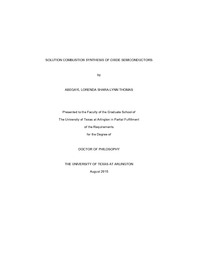| dc.description.abstract | The quest for stable and efficient photocatalytic materials beyond TiO2 and WO3 has over the years led to the development of new materials that possess varied interfacial energetics. This dissertation study focused on using for the first time a novel method, solution combustion synthesis (SCS), to prepare two distinct families of binary metal-based oxide semiconductor materials. Detailed studies on material characteristics and applications were carried out on tungsten- and niobium-based oxide semiconductors with varying principal metals. Initial emphasis was placed on the SCS of tungsten-based oxide semiconductors (ZnWO4, CuWO4, and Ag2WO4). The influence of different tungsten precursor’s on the resultant product was of particular relevance to this study, with the most significant effects highlighted. Upon characterization, each sample’s photocatalytic activity towards methyl orange dye degradation was studied, and benchmarked against their respective commercial oxide sample, obtained by solid-state ceramic synthesis. Detailed analysis highlighted the importance of the SCS process as a time- and energy-efficient method to produce crystalline nano-sized materials even without additional or excessive heat treatment. It was observed that using different tungstate precursors does influence the structural and morphological make-up of the resulting materials. The as-synthesized tungstate materials showed good photocatalytic performance for the degradation of methyl orange dye, while taking into account specific surface area and adsorbed dye amount on the surface of the material. Like the tungstate’s, niobium-based oxide semiconductors CuNb2O6 and ZnNb2O6 were the first to be synthesized via solution combustion synthesis. Particular attention was placed on the crystal structures formed while using an oxalate niobium precursor during the reaction process. X-ray patterns yielded a multiphase structure for the ZnNb2O6 and a single phase structure for CuNb2O6. Photoelectrochemical (PEC) measurements were used both as a characterization tool as well as an application for CO2 reduction. The PEC data was consistent with an n-type and p-type semiconductor for ZnNb2O6 and CuNb2O6 respectively. Good phototelectrochemical behavior was observed for CuNb2O6 with stable, high photocurrents suggesting a suitable material for CO2 reduction while in a 0.1 M NaHCO3 + CO2 medium. All in all, this dissertation study expounds on metal ion insertion into various structural frameworks (e.g. WO3) which may open sustainable materials chemistry avenues to solar energy conversion and environmental remediation. | en_US |

